All about NuWave Wetsuits
Let's talk about C-Skins new product - NuWave Natural Rubber Wetsuits.
They shared the following information with us on everything you need to know.
What is Natural Rubber?
"Wetsuits are made from panels of foamed rubber that are usually covered in a woven fabric for protection and durability. That foamed rubber has traditionally been neoprene, the trade name for a synthetic rubber made from either limestone or oil. Natural rubber, on the other hand, comes from trees.
How is Natural Rubber Produced?
Some flowering plants and trees (around 10%) produce a fluid called latex that they secrete when damaged as a defence reaction to plant-eating insects and animals. Latex, which is different to sap, is a milky fluid present in the stems and roots of these plants that coagulates when exposed to air and is the raw material for natural latex or, with further processing, natural rubber. The primary source of commercial natural rubber is the Hevea tree, commonly referred to as the rubber tree or rubber plant.
Hevea trees need to be at least five years old before they can be tapped for latex – the process of stripping off a sliver of bark then making a cut across the latex vessels that grow in a spiral up the trunk of the tree and hanging a bucket beneath it to collect the latex that flows out. The cut is not deep enough to harm the tree, so the tree can continue to grow and produce latex. Whilst hevea trees can live for up to 100 years, latex production declines with age so most commercial rubber trees in plantations are felled after 25-30 years and a new tree planted in its place
Latex contains a high volume of water that must first be reduced to create concentrated latex for commercial use and that can then be processed with heat to create solid natural rubber. The production partner of C-Skins receives natural rubber as a solid that they then process to create foamed natural rubber as an alternative to neoprene.
Is Hevea Rubber Better Because It’s Natural?
Hevea rubber is better for the environment and the workers processing the raw material along the supply chain than neoprene.
Many early criticisms of natural rubber wetsuits were that it was heavier and not as flexible, but our range of NuWave wetsuits are proof that that is no longer the case – natural rubber foam’s performance is really good and ever improving.
NuWave, Natural Rubber, And The Environment
NuWave wetsuits are made from a blend of 85% natural rubber and 15% chlorine free synthetic rubber (as a percentage of total foam rubber content) to optimise the natural rubber foam's longevity, durability and stretch. This is covered with a woven lining to protect the natural rubber from ultraviolet degradation.
In addition, any smooth skin, mesh, or otherwise non-porous single-lined foam as would traditionally be used on the inside of the neck for comfort or on the torso and back, can only be produced from synthetic rubber. Because of this limitation, we've designed our NuWave wetsuits accordingly and the only glide skin used on them has been limited to the absolute minimum on the collar and the o-ring seal on the edge of the shoulder piece, by the cinch - essential for comfort and to provide a satisfactory seal.
At 85% natural rubber composition, it has been estimated that the carbon footprint of the wetsuit is reduced by up to 80% compared to a neoprene wetsuit. Most natural rubber, around 88%, is grown in South and Southeast Asia (mostly on small-holdings), close to our production partner’s manufacturing facilities, so raw material transportation is reduced compared to limestone neoprene originating from Japan.
The natural rubber used in our NuWave suits comes from FSC certified (Forestry Stewardship Council) sources, and the foaming process is also FSC certified. It is REACH compliant, RoHS compliant, and meets environmental standards for PAHs. The final foam is a USDA certified biobased product at 63% - the non-biobased certified content is eco carbon black (made from recycled scrap car tyres), oyster shell powder and oils, including soybean oil.
What Does FSC Certification Mean?
Forest Stewardship Council (FSC) certification indicates that wood or tree-products are produced and harvested responsibly. Old growth forests are maintained and protected, as are plant and animal species. Workers are paid a fair wage and provided a safe working environment, and local communities living in and around forest areas are consulted, and their legal and cultural rights to land and forest resources are respected.
We are excited to be making natural rubber wetsuits available to C-Skins customers with our next range. The move to offer a plant-based alternative with minimal environmental impact is a natural progression for us. It is the latest step in our efforts to minimise our impact, but not the last."

How much time do you spend in a wetsuit in an average week?
Through the summer months, I definitely find myself putting a long shift in. In that summer holiday period I’m in a wetsuit for a minimum of 24 hours each week if you count my own surfs before and after work and all the surf lessons I’m coaching through the week. [Editor’s note – Logan clocked up over 500 surfs in 2022 and had no intention of slowing down in 2023, so probably spends more time in a wetsuit each month than most surfers do in a year making him the ideal person to test how durable a wetsuit is.
What do you need and look for in a wetsuit?
I’m really after a suit that’s comfortable and fit for season. When I say: “fit for season”, I’m obviously looking for different things at different times of the year from a wetsuit. In the winter my main priority is warmth whereas in the summer I’m looking for something high performance and non restrictive. These days it’s pretty amazing how you can tick every box and cover all bases with your wetsuits regardless of the time of year.
What were your first impressions when you got your hands on a NuWave wetsuit?
The new look is really impressive, but the main thing that was really exciting for me was that I ended up asking myself “What’s the difference?” The suit felt just as high quality, stretchy and soft as all of the previous C Skins wetsuits that I’ve owned. I’d tried not to have any preconceptions but I guess I was a bit surprised that I couldn’t even tell the difference.
How have you tested this wetsuit?
I really put my summer wetsuit I put through its paces! I took it on tour with me to compete in the WSL European Qualifying Series contests, used it throughout the summer at the surf school, and also in my day-to-day training at home. Coaching-wise, I was kept super warm and it was comfy enough to wear in all my lessons through the summer. I’ve been really impressed with the wetsuit, just as I have been with every other C Skins wetsuit that I’ve had.
How has it performed both in the water and out?
The performance has been great! It’s pretty flexible, and the warmth and comfort of the suit have been what I’ve liked about it the most. The drying time is very similar to my previous C Skins suits as well. It just constantly amazes me that it is made from natural rubber!
There we have it, a breakdown from a very in-depth document on how the NuWave Natural Rubber Wetsuits from C-Skins, were born and a review from Team Rider, Logan Nicol.
We hope you found this blog informative and consider choosing natural wetsuits to help lower the impacts on our Environment.
Shop the full range of NuWave Suits here
Related Posts
By accepting you will be accessing a service provided by a third-party external to https://www.escape-watersports.co.uk/






